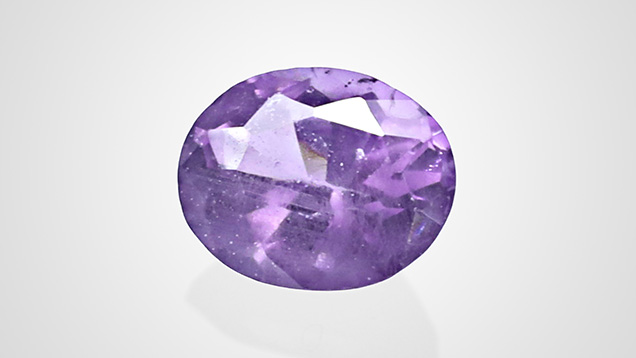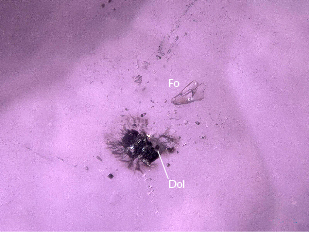Forsterite in a Purple Tanzanian Spinel

Purple/violet spinel from Tanzania is popular in the gem market today. Recently, author JW encountered an oval-shaped purple gemstone reportedly from Tanzania (figure 1). Its refractive index of 1.714 and hydrostatic specific gravity of 3.59 indicated spinel. Its ultraviolet/visible/near-infrared (UV-Vis-NIR) absorption spectrum was characterized by a series of absorption bands centered at 555 nm and several iron-related small bands centered at around 371, 385, 461, and 478 nm, as well as an extremely weak band at ~625 nm for Co2+ (figure 2). This absorption profile revealed that iron (Fe2+ and Fe3+) was the main coloring element (P.M. Belley and A.C. Palke, “Purple gem spinel from Vietnam and Afghanistan: Comparison of trace element chemistry, cause of color, and inclusions,” Fall 2021 G&G, pp. 228–238).

Energy-dispersive X-ray fluorescence analysis was performed to determine the sample’s trace element concentration, which showed 10950 ppmw iron, 963 ppmw zinc, 52 ppmw chromium, 94 ppmw vanadium, and 9 ppmw cobalt. These results were similar to the chemical features of representative purple Tanzanian spinel: extremely high iron content, medium zinc content, and low chromium and vanadium contents (G. Giuliani et al., “Pink and red spinels in marble: Trace elements, oxygen isotopes, and sources,” Canadian Mineralogist, Vol. 55, No. 4, 2017, pp. 743–761).

Microscopic observation revealed a colorless subhedral mineral, a dolomite with an unknown dark material attached (figure 3), and oriented short needles (figure 4). Raman spectroscopy identified the colorless mineral as forsterite. According to the RRUFF database (B. Lafuente et al., https://rruff.info/about/downloads/HMC1-30.pdf), peaks at 822, 855, 918, and 963 cm−1 were consistent with the main peaks of forsterite (figure 5).

As a rock-forming mineral, forsterite (Mg2SiO4) itself is common, especially in marble-hosted spinel. However, it is rarely observed in Tanzanian spinel and has been reported only once to our knowledge (E. Gübelin and J.I. Koivula, Photoatlas of Inclusions in Gemstones, Volume 2, Opinio Publishers, Basel, Switzerland, 2005, 829 pp.).
In Tanzania, the primary deposits of spinel occur in marbles and calc-silicate rocks that belong to the Neoproterozoic metamorphic Mozambique Belt (G. Giuliani et al., “Les gisements de rubis et de spinelle rouge de la Ceinture Métamorphique Néoprotérozoıque Mozambicaine,” Revue de Gemmologie, Vol. 192, 2015, pp. 11–18). Under high-temperature conditions, spinel and forsterite are both stable mineral phases in marbles (Giuliani et al., 2017). Spinel is found in marble or impure marble associated with calcite, dolomite, forsterite, clinohumite, and phlogopite in deposits in Myanmar and Vietnam. Thus, forsterite is commonly seen as an inclusion in spinel from these sources (G. Giuliani et al., “Pink and red gem spinels in marble and placers,” InColor, No. 43, 2019, pp. 14–28).
It was noteworthy to see forsterite in the Tanzanian sample. This finding could indicate a similar formation environment between spinel in Tanzanian deposits and those in Myanmar and Vietnam.



